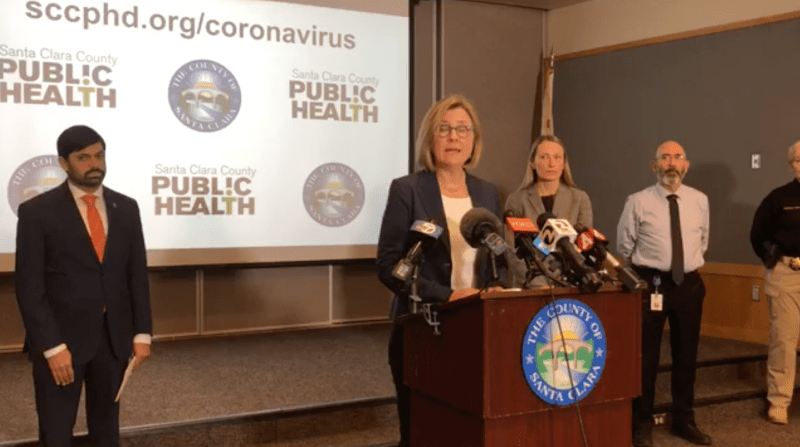Local congressional representatives joined Santa Clara County Public Health Department (SCCPHD) Director Sara Cody in hosting a coronavirus “tele-town hall” on Tuesday. Cody spoke to the importance of complying with the stay-at-home order and providing accurate testing data, while the representatives advocated for a Democratic House relief bill.
The call had over 7,000 participants with “several hundred” people waiting to ask questions, according to Rep. Zoe Lofgren (D-San Jose), who was joined by Rep. Jimmy Panetta (D-Carmel Valley), Rep. Anna Eshoo (D-Palo Alto) and Rep. Ro Khanna (D-Fremont) on the call.
Cody praised county groups working on preparing the healthcare system for an influx of coronavirus patients and seeking housing for people in the county. The Santa Clara County Board of Supervisors unanimously approved a countywide eviction moratorium on Tuesday, lasting until May 31. Board President Cindy Chavez has expressed confidence that “the supervisors will extend it until the coronavirus crisis subsides,” according to a press release.
County cases climb
On Tuesday, Santa Clara County released an order instructing labs testing individuals for COVID-19 to report negative and inconclusive results. Previously, only positive test results had to be reported to the county.
“That’s going to give us a much better sense for how widespread testing is in our county,” Cody said. “It can also tell us what proportion of people are testing positive, and we can identify if there are areas in our communities where there seems to be a greater degree of spread of the virus, then we can take action.”
Stanford has performed 3,575 tests across the greater Bay Area as of March 20, according to Stanford Health Care spokesperson Julie Greicius.
There are 375 people in the County who have tested positive for COVID-19, and 16 people have died as of 5 p.m. on Monday, according to SCCPHD. Cody said that Santa Clara County makes up about 22% of cases and almost 60% of the deaths recorded in California due to coronavirus, adding that the numbers represented only the “tip of the iceberg.”
“The numbers of cases that we’re reporting represents the most severe,” Cody said. “A number of our cases are hospitalized or in the ICU; that mostly reflects who we’re testing.”
Khanna praised Santa Clara County and the Bay Area for their response to coronavirus, commending the work of medical professionals and citing efforts to provide N95 masks and shelter-in-place orders as positive steps for the region.
“We were one of the first places in the entire country to shelter-in-place,” Khanna said. “I think they should have had the shelter-in-place throughout the entire country a week ago.”
Cody noted that the impact of the state’s stay-at-home restrictions would not be seen in the data immediately.
“Our data are imperfect,” she said, urging people in the county to “do their part,” as “many of our actions are designed around trying to protect the most vulnerable groups and slow the spread of infection.”
One caller asked what the county would do if President Donald Trump “says it’s time to go back to normal.” Trump expressed opposition to social distancing and business shutdown guidelines in a Fox News town hall on Tuesday, stating that he “would love to have the country opened up, and just raring to go, by Easter,” according to The New York Times.
Cody said the county needed to continue implementing restrictions that constituted “an enormous, enormous hardship” to save lives.
“They’re going to need to be in place for a bit of time,” she said. “We know from experience looking around the world that what we’re doing now with these broad measures is necessary, and it will save lives.”
‘Who are you going to value the most’
The representatives fielded questions from callers, ranging from worries about finding funding to sustain small businesses and pay healthcare costs to queries about relief for the airline industry.
In response, Lofgren, Eshoo, Panetta and Khanna repeatedly invoked the merits of the House Democrats’ 1,400-page relief bill, arguing that the bill provided more protections for average Americans than the relief bill spearheaded by Senate Republicans. Senate leaders reached a deal on a bipartisan bill Tuesday evening that is predicted to be signed into law within days, according to The New York Times.
“God willing, we will have a consensus in Congress shortly,” Eshoo said. “April 1 is fast approaching. People have to pay their mortgage or their rent. This is not about the very top. This is about extraordinary ordinary people across our country that are struggling.”
Lofgren added that the gridlock in Congress over the relief bill amounted to more than “squabbling.”
“It’s really a clash of who are you going to value the most,” Lofgren said. “Big corporations who bought back stock and now want relief for that or the employees who are having to meet their day to day payments, their mortgage payments or food payments without a paycheck?”
One caller asked whether Democrats were playing “political football” with the bill by “adding a lot of extra stuff in addition to the needed aid,” citing concerns that unnecessary provisions had been added to limit Immigrations and Customs Enforcement (ICE) and reduce airplane emissions.
Lofgren responded that “a lot of what you’ve heard is being suggested by people who oppose what we’re doing.”
She said provisions that appeared on face unrelated to the relief effort were necessary, such as a vote-by-mail provision written to safeguard against threats to cancel the November elections.
“We probably won’t get everything that’s in it to the Senate, but it’s a good, solid emergency package,” Lofgren said.
March 25, 12:11 a.m.: This article has been updated to reflect that the Senate reached a deal on a relief bill on Tuesday night.
